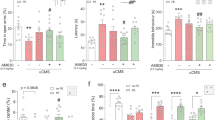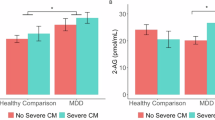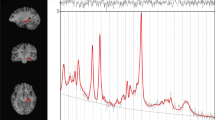Abstract
The efficacy of antidepressants has been linked in part to their ability to reduce activity of the hypothalamic–pituitary–adrenal (HPA) axis; however, the mechanism by which antidepressants regulate the HPA axis is largely unknown. Given that recent research has demonstrated that endocannabinoids can regulate the HPA axis and exhibit antidepressant potential, we examined the hypothesis that the endocannabinoid system is regulated by long-term antidepressant treatment. Three-week administration of the tricyclic antidepressant desipramine (10 mg/kg/day) resulted in a significant increase in the density of the cannabinoid CB1 receptor in the hippocampus and hypothalamus, without significantly altering endocannabinoid content in any brain structure examined. Furthermore, chronic desipramine treatment resulted in a reduction in both secretion of corticosterone and the induction of the immediate early gene c-fos in the medial dorsal parvocellular region of the paraventricular nucleus of the hypothalamus (PVN) following a 5 min exposure to swim stress. Acute treatment with the CB1 receptor antagonist, AM251 (1 mg/kg), before exposure to swim stress, completely occluded the ability of desipramine to reduce both corticosterone secretion and induction of c-fos expression in the PVN. Collectively, these data demonstrate that CB1 receptor density in the hippocampus and hypothalamus is increased by chronic tricyclic antidepressant treatment, and suggest that this upregulation could contribute to the ability of tricyclic antidepressants to suppress stress-induced activation of the HPA axis.
Similar content being viewed by others
Log in or create a free account to read this content
Gain free access to this article, as well as selected content from this journal and more on nature.com
or
References
Appelhof BC, Huyser J, Verweij M, Brouwer JP, van Dyck R, Fliers E et al (2006). Glucocorticoids and relapse of major depression (dexamethasone/corticotropin-releasing hormone test in relation to relapse of major depression). Biol Psychiatry 59: 696–701.
Arborelius L, Owens MJ, Plotsky PM, Nemeroff CB (1999). The role of corticotrophin-releasing factor in depression and anxiety disorders. J Endocrinol 160: 1–12.
Barna I, Zelena D, Arszovszki AC, Ledent C (2004). The role of endogenous cannabinoids in the hypothalamo–pituitary–adrenal axis regulation: in vivo and in vitro studies in CB1 receptor knockout mice. Life Sci 75: 2959–2970.
Bielski RJ, Friedel RO (1976). Prediction of tricyclic antidepressant response: a critical review. Arch Gen Psychiatry 33: 1479–1489.
Butterweck V, Winterhoff H, Herkenham M (2001). St John's wort, hypericin and imipramine: a comparative analysis of mRNA levels in brain areas involved in HPA axis control following short-term and long-term administration in normal and stressed rats. Mol Psychiatry 6: 547–564.
Connor TJ, Kelliher P, Shen Y, Harkin A, Kelly JP, Leonard BE (2000). Effect of subchronic antidepressant treatments on behavioral, neurochemical and endocrine changes in the forced swim test. Pharmacol Biochem Behav 65: 591–597.
Connor TJ, Kelly JP, Leonard BE (1998). Forced swim test-induced endocrine and immune changes in the rat: effect of subacute desipramine treatment. Pharmacol Biochem Behav 59: 171–177.
Conti, AC, Kuo YC, Valentino RJ, Blendy JA (2004). Inducible cAMP early repressor regulates corticosterone suppression after tricyclic antidepressant treatment. J Neurosci 24: 1967–1975.
de Bellis MD, Gold PW, Geracioti Jr TD, Listwak SJ, Kling MA (1993). Association of fluoxetine treatment with reductions in CSF concentrations of corticotropin-releasing hormone and arginine vasopressin in patients with major depression. Am J Psychiatry 150: 656–657.
de Medeiros MA, Carlos Reis L, Eugenio Mello L (2005). Stress-induced c-Fos expression is differentially modulated by dexamethasone, diazepam and imipramine. Neuropsychopharmacology 30: 1246–1256.
Di S, Malcher-Lopes R, Halmos KC, Tasker JG (2003). Nongenomic glucocorticoid inhibition via endocannabinoid release in the hypothalamus: a fast feedback mechanism. J Neurosci 23: 4850–4857.
Duncan GE, Knapp DJ, Johnson KB, Breese GR (1996). Functional classification of antidepressants based on antagonism of swim stress-induced fos-like immunoreactivity. J Pharmacol Exp Ther 277: 1067–1089.
Frazer A (1997). Antidepressants. J Clin Psychiatry 58(Suppl 6): 9–25.
Giuffrida A, Parsons LH, Kerr TM, Rodriguez de Fonseca F, Navarro M, Piomelli D (1999). Dopamine activation of endogenous cannabinoid signaling in dorsal striatum. Nat Neurosci 2: 258–263.
Gobbi G, Bambico FR, Mangieri R, Bortolato M, Campolongo P, Solinas M et al (2005). Antidepressant-like activity and modulation of brain monoaminergic transmission by blockade of anandamide hydrolysis. Proc Natl Acad Sci USA 102: 18620–18625.
Gold PW, Chrousos GP (2002). Organization of the stress system and its dysregulation in melancholic and atypical depression: high vs low CRH/NE states. Mol Psychiatry 7: 254–275.
Greden F, Gardner R, King D, Grunhaus L, Carroll J, Kronfol Z (1983). Dexamethasone suppression test in antidepressant treatment of melancholia. Arch Gen Psychiatry 40: 493–500.
Herman JP, Dolgas CM, Carlson SL (1998). Ventral subiculum regulates hypothalamo–pituitary–adrenocortical and behavioural responses to cognitive stressors. Neuroscience 86: 449–459.
Hill MN, Gorzalka BB (2005a). Pharmacological enhancement of cannabinoid CB1 receptor activity elicits an antidepressant-like response in the rat forced swim test. Eur Neuropsychopharmacol 15: 593–599.
Hill MN, Gorzalka BB (2005b). Is there a role for endocannabinoids in the pathophysiology and treatment of melancholic depression? Behav Pharmacol 16: 333–352.
Hill MN, Patel S, Carrier EJ, Rademacher DJ, Ormerod BK, Hillard CJ et al (2005a). Downregulation of endocannabinoid signaling in the hippocampus following chronic unpredictable stress. Neuropsychopharmacology 30: 508–515.
Hill MN, Sun JC, Tse MTL, Gorzalka BB (2005b). Alteration in serotonin receptor responsiveness following long-term cannabinoid treatment. Int J Neuropsychopharmacol (in press).
Holsboer F (2000). The corticosteroid receptor hypothesis of depression. Neuropsychopharmacology 23: 477–501.
Holsboer F, Barden N (1996). Antidepressants and hypothalamic–pituitary–adrenocortical regulation. Endocr Rev 17: 187–205.
Jacobson L, Sapolsky R (1991). The role of the hippocampus in feedback regulation of the hypothalamic–pituitary–adrenocortical axis. Endocr Rev 12: 118–134.
Jiang W, Zhang Y, Xiao L, Van Cleemput J, Ji S-P, Bai G et al (2005). Cannabinoids promote embryonic and adult hippocampus neurogenesis and produce anxiolytic- and antidepressive-like effects. J Clin Invest 115: 3104–3116.
Leterrier C, Bonnard D, Carrel D, Rossier J, Lenkei Z (2004). Constitutive endocytic cycle of the CB1 cannabinoid receptor. J Biol Chem 279: 36013–36021.
Martin M, Ledent C, Parmentier M, Maldonado R, Valverde O (2002). Involvement of CB1 cannabinoid receptors in emotional behaviour. Psychopharmacology 159: 379–387.
Martinez-Turrillas R, Frechilla D, Del Rio J (2002). Chronic antidepressant treatment increases the membrane expression of AMPA receptors in rat hippocampus. Neuropharmacology 43: 1230–1237.
Michelson D, Galliven E, Hill L, Demitrack M, Chrousos G, Gold P (1997). Chronic imipramine is associated with diminished hypothalamic–pituitary–adrenal axis responsivity in healthy humans. J Clin Endocrinol Metab 82: 2601–2606.
Miller GE, Hill MN, Ho WSV, Gorzalka BB, Hillard CJ (2005). Bidirectional alterations in serum endocannabinoids in minor and major depression. Soc Neurosci Abstr 107: 3.
Mueller NK, Doglas CM, Herman JP (2004). Stressor-selective role of the ventral subiculum in regulation of neuroendocrine stress responses. Endocrinology 145: 3763–3768.
Pariante CM, Papadopoulos AS, Poon L, Cleare AJ, Checkley SA, English J et al (2004). Four days of citalopram increase suppression of cortisol secretion by prednisolone in healthy volunteers. Psychopharmacology 177: 200–206.
Parker KJ, Schatzberg AF, Lyons DM (2003). Neuroendocrine aspects of hypercortisolism in major depression. Horm Behav 43: 60–66.
Patel S, Carrier EJ, Ho WS, Rademacher DJ, Cunningham S, Reddy DS et al (2005a). The postmortal accumulation of brain N-arachidonylethanolamine (anandamide) is dependent upon fatty acid amide hydrolase activity. J Lipid Res 46: 342–349.
Patel S, Rademacher DJ, Hillard CJ (2003). Differential regulation of the endocannabinoids anandamide and 2-arachidonylglycerol within the limbic forebrain by dopamine receptor activity. J Pharmacol Exp Ther 306: 880–888.
Patel S, Roelke CT, Rademacher DJ, Cullinan WE, Hillard CJ (2004). Endocannabinoid signaling negatively modulates stress-induced activation of the hypothalamic–pituitary–adrenal axis. Endocrinology 145: 5431–5438.
Patel S, Roelke CT, Rademacher DJ, Hillard CJ (2005b). Inhibition of restraint stress-induced neural and behavioural activation by endogenous cannabinoid signalling. Eur J Neurosci 21: 1057–1069.
Reul JM, Stec I, Soder M, Holsboer F (1993). Chronic treatment of rats with the antidepressant amitriptyline attenuates the activity of the hypothalamic–pituitary–adrenocortical system. Endocrinology 133: 312–320.
Ribeiro SC, Tandon R, Grunhaus L, Greden JF (1993). The DST as a predictor of outcome in depression: a meta-analysis. Am J Psychiatry 150: 1618–1629.
Rush AJ, Weissenburger JE (1994). Melancholic symptom features and DSM-IV. Am J Psychiatry 151: 489–498.
Schlicker E, Timm J, Zentner J, Gothert M (1997). Cannabinoid CB1 receptor-mediated inhibition of noradrenaline release in the human and guinea-pig hippocampus. Naunyn Schmiedebergs Arch Pharmacol 356: 583–589.
Stout SC, Owens MJ, Nemeroff CB (2002). Regulation of corticotropin-releasing factor neuronal systems and hypothalamic–pituitary–adrenal axis activity by stress and chronic antidepressant treatment. J Pharmacol Exp Ther 300: 1085–1092.
Tzavara ET, Perry KW, Rodriguez DE, Bymaster FP, Nomikos GG (2001). The cannabinoid CB(1) receptor antagonist SR141716A increases norepinephrine outflow in the rat anterior hypothalamus. Eur J Pharmacol 426: R3–R4.
Viau V, Bingham B, Davis J, Lee P, Wong M (2005). Gender and puberty interact on the stress-induced activation of parvocellular neurosecretory neurons and corticotropin-releasing hormone messenger ribonucleic acid expression in the rat. Endocrinology 146: 137–146.
Viau V, Sawchenko PE (2002). Hypophysiotropic neurons of the paraventricular nucleus respond in spatially, temporally, and phenotypically differentiated manners to acute vs repeated restraint stress. J Comp Neurol 445: 293–307.
Witkin JM, Tzavara ET, Nomikos GG (2005). A role for cannabinoid CB1 receptors in mood and anxiety disorders. Behav Pharmacol 16: 315–331.
Wong EH, Sonders MS, Amara SG, Tinholt PM, Piercey MF, Hoffmann WP et al (2000). Reboxetine: a pharmacologically potent, selective, and specific norepinephrine reuptake inhibitor. Biol Psychiatry 47: 818–829.
Young EA, Altemus M, Lopez JF, Kocsis JH, Schatzberg AF, DeBattista C et al (2004). HPA axis activation in major depression and response to fluoxetine: a pilot study. Psychoneuroendocrinology 29: 1198–1204.
Zobel AW, Nickel T, Sonntag A, Uhr M, Holsboer F, Ising M (2001). Cortisol response in the combined dexamethasone/CRH test as predictor of relapse in patients with remitted depression: a prospective study. J Psychiatr Res 35: 83–94.
Acknowledgements
This research was supported by an Independent Investigator NARSAD Award and R01 DA16967 to CJH; a Natural Sciences and Engineering Research Council of Canada (NSERC) operating grant to BBG; a Canadian Institute of Health Research operating grant to BBG and VV; and a Michael Smith Foundation for Health Research postgraduate trainee award and an NSERC Canadian Graduate Scholarship to MNH. We thank Larissa Froese, Anna Morrish, Maric Tse, Brenda Bingham, Patricia Lee, Craig Roelke, Sarah Meier, Jennifer Barker, and Wayne Yu for their technical assistance.
Author information
Authors and Affiliations
Corresponding author
Rights and permissions
About this article
Cite this article
Hill, M., Ho, WS., Sinopoli, K. et al. Involvement of the Endocannabinoid System in the Ability of Long-Term Tricyclic Antidepressant Treatment to Suppress Stress-Induced Activation of the Hypothalamic–Pituitary–Adrenal Axis. Neuropsychopharmacol 31, 2591–2599 (2006). https://doi.org/10.1038/sj.npp.1301092
Received:
Revised:
Accepted:
Published:
Issue date:
DOI: https://doi.org/10.1038/sj.npp.1301092
Keywords
This article is cited by
-
How depression and antidepressant drugs affect endocannabinoid system?—review of clinical and preclinical studies
Naunyn-Schmiedeberg's Archives of Pharmacology (2024)
-
Endocannabinergic modulation of central serotonergic activity in healthy human volunteers
Annals of General Psychiatry (2023)
-
Peripheral endocannabinoid serum level in association with repetitive transcranial magnetic stimulation (rTMS) treatment in patients with major depressive disorder
Scientific Reports (2021)
-
Integrating Endocannabinoid Signalling In Depression
Journal of Molecular Neuroscience (2021)
-
Pharmacogenetics and Imaging–Pharmacogenetics of Antidepressant Response: Towards Translational Strategies
CNS Drugs (2016)



